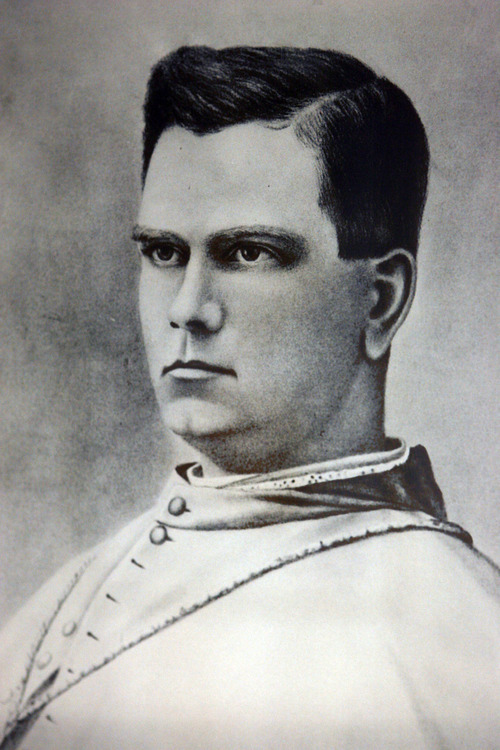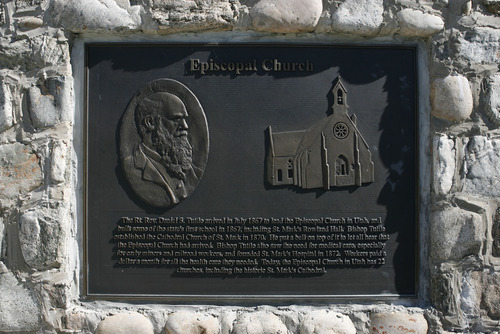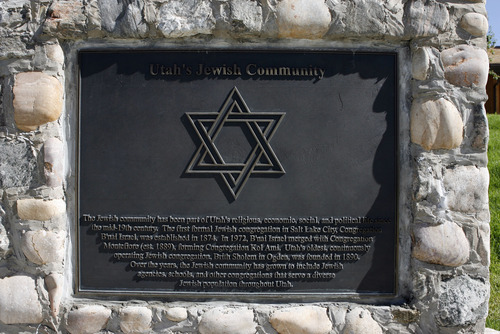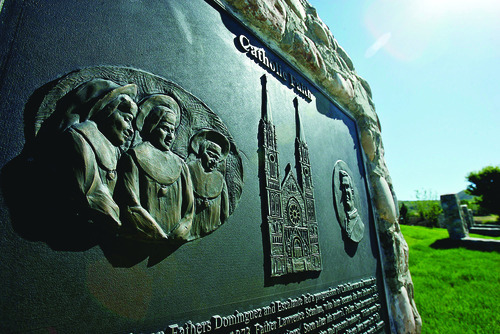This is an archived article that was published on sltrib.com in 2011, and information in the article may be outdated. It is provided only for personal research purposes and may not be reprinted.
This Is The Place Heritage Park derived its name from a comment made by Mormon prophet Brigham Young, the leader of a beleaguered band of Latter-day Saints, as he looked down from the mouth of Emigration Canyon onto the nearly barren valley below.
But within a few years, pioneers of other denominations discovered Utah was the right place for them, too.
Catholics, Jews, Greek Orthodox and mainline Protestants came seeking jobs in the mines, in the fields, on ranches. They came as adventurers, exploring new lands. They came to win back Mormon converts to their previous churches. They set up schools and hospitals; churches, temples and synagogues. They served the poor and the wayward and the unwanted.
This Is The Place park now has put that diversity in bronze to honor early settlers from religious traditions outside of Mormonism.
The park is not just for Mormons, insists Ellis Ivory, who oversees the state attraction. "It's for everyone."
Ivory believes a more inclusive approach aligns with the vision of the park's creators.
In 1921, the state dedicated its first This Is The Place Monument with a simple white obelisk marking the place and a tribute to the contributions of those who came before.
"Behold all men dwelling in peace here, in this, one of the cities of Zion. Jew and Gentile, Mormon and Catholic, believer and skeptic — none more free than those living here," LDS general authority B.H. Roberts told the assembled crowd at the dedication, "none more secure in their property rights and religious freedom — 'This is the place,' for the enjoyment of these things."
By 1947, the obelisk was replaced by a multitiered pedestal, with Young and his Mormon compatriots depicted on top, while American Indians, explorers and leaders of other faiths, graced the lower levels.
Ivory, who was appointed the park's CEO this year, thought that engaging more Utah communities would lead to wider public support for the attraction on the Salt Lake Valley's east bench. He came up with the idea of a "Walk of Pioneer Faiths" that would honor nine religious groups with plaques.
On June 29, representatives of each faith, including Mormon apostle M. Russell Ballard, joined Ivory for an unveiling and dedication of the plaques, created by Utah artist Stan Watts and located near a recently completed area known as "The Garden Place."
"We give thanks for all this place represents," Catholic Bishop John C. Wester said that day. "We are one people. We are one state. We are brothers and sisters, with God as our father."
The park is "sacred to all of us," Wester said. "It is part of all our history. It celebrates all of us."
Plaques include these tidbits:
Catholic • Franciscan Fathers Dominguez and Escalante came first. Then, in 1873, the Rev. Lawrence Scanlan, who became the state's first Catholic bishop, arrived. Scanlan, in turn, invited Holy Cross Sisters to assist with health care, education and pastoral ministry.
Jewish • Congregation B'nai Israel was established in 1874, followed by Congregation Montefiore. Nearly 100 years later, they merged to create Congregation Kol Ami. Utah's oldest continuously operating Jewish congregation, Brith Sholem in Ogden, was founded in 1890.
First Congregational Church • The Rev. Norman McLeod of Denver became the first Protestant minister in the Salt Lake Valley, preaching his first sermon on Jan. 22, 1865.
Episcopal • Bishop Daniel S. Tuttle came to lead the church in 1867 and thereafter established St. Mark's Episcopal Cathedral, schools and medical care for early miners and railroad workers.
Methodist • The first Methodist churches were planted in Corinne, Ogden and Salt Lake City in 1870, and in Tooele in 1871. They were following in the footsteps of Jedediah Strong Smith, a Methodist explorer who traversed the state in 1825 and 1826.
Baptist • Rather than ordained clergy, Annie and James Berkley, laypersons from Ohio, laid down Baptist roots in 1871. They had worshipped with a small congregation led by Rev. George W. Dodge, a Baptist minister who served as the governor of Indian Affairs for the Utah Territory. A decade later, they were the only remnants of Dodge's flock.
Presbyterian • The Rev. Josiah Welch arrived on Sept. 28, 1871; a month later, he organized the First Presbyterian Church with 12 members.
Lutheran • Many Lutherans came to Utah to work on the railroad or as merchants, building enough of a population to create the first Lutheran Church in Salt Lake City by 1882.
Greek Orthodox • Greek immigrants, drawn by mining, started arriving by the thousands in 1900. They built the first Holy Trinity Greek Orthodox Church at 439 W. 400 South, a few blocks from the current Holy Trinity cathedral.













